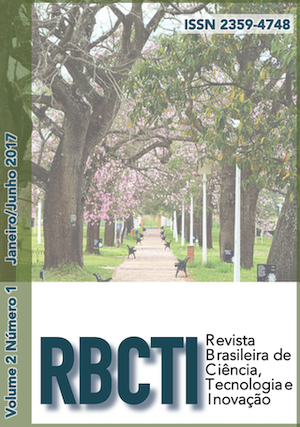Aplicação de LC-SPE/NMR na rápida identificação de compostos orgânicos em fitoterápico
DOI:
https://doi.org/10.18554/rbcti.v2i1.776Palavras-chave:
LC-SPE/NMR, Ilex paraguariensis, hifenaçãoResumo
Este artigo descreve a análise do perfil químico de um medicamento fitoterápico à base de Ilex paraguariensis utilizando a tecnologia acoplada LC-SPE/NMR, que levou à rápida separação e identificação de oito compostos orgânicos em um único experimento. Dessa forma, metodologias clássicas de isolamento não foram necessárias. A alta seletividade alcançada na separação cromatográfica, somada à adequada retenção por SPE e a aplicação da tecnologia criogênica de RMN de alto campo magnético (14,1 Tesla) permitiu a obtenção de dados conclusivos acerca das estruturas encontradas, eliminando a necessidade de experimentos por espectrometria de massa.
Referências
AKIRA K. et al. LC-NMR identification of a novel taurine-related metabolite observed in 1H NMR-based metabonomics of genetically hypertensive rats. J. Pharmaceut. Biomed. n. 51, vol. 5, 2010. p. 1091-1096.
BAYER, E. et al. On-line coupling of high-performance liquid chromatography and nuclear magnetic resonance. J. Chromatogr. n. 186, 1979. p. 497-451.
BRINGMANN, G.; LANG, G. Full absolute stereostructures of natural products directly from crude extracts: the HPLC-MS/MS-NMR-CD triad. Mar. Mol. Biotec. n. 89, 2003. p. 89-116.
CLARKSON, C. et al. Evaluation of on-line solid-phase extraction parameters for hyphenated, high-performance liquid chromatography–solid-phase extraction–nuclear magnetic resonance applications. J. Chromatogr. A. n. 1165, vol. 1-2, 2007. p. 1 – 9.
ELIPE, M. V. S. Advantages and disadvantages of nuclear magnetic resonance spectroscopy as a hyphenated technique. Anal. Chim. Acta. n. 497, 2003. p. 1-25.
EXARCHOU, V. et al. LC–NMR coupling technology: recent advancements and applications in natural products analysis. Magn. Reson. Chem. n. 43, 2005. p. 681-687.
EXARCHOU, V. et al. LC-UV-Solid-Phase extraction-NMR-MS combined with a cryogenic flow probe and its application to the identification of compounds present in greek oregano. J. Anal. Chem. n. 75, 2003. p. 6288-6294.
GAO, H. et al. Rapid structural identification of cytotoxic bufadienolide sulfates in toad venom from Bufo melanostictus by LC-DAD-MSn and LC-SPE-NMR. J. Nat. Prod. n. 73, 2010. p. 603-608.
LE GALL G. et al. Characterization and content of flavonoid glycosides in genetically modified tomato (Lycopersicon esculentum) fruits. J. Agric. Food Chem. n. 51, vol. 9, 2003. p. 2438-2446.
LEVSEN, K. et al. Application of high-performance liquid chromatography coupled to nuclear magnetic resonance and high-performance liquid chromatography coupled to mass spectrometry to complex environmental samples. Trends Anal. Che. n. 19, vol. 1, 2000. p. 27-48.
NOVAK P. et al. LC–NMR and LC–MS identification of an impurity in a novel antifungal drug icofungipen. J. Pharmaceut. Biomed. n. 50, vol. 1, 2009. p. 68-72.
NOVAK, P. et al. The application of LC–NMR and LC–MS for the separation and rapid structure elucidation of an unknown impurity in 5-aminosalicylic acid. J. Pharmaceut. Biomed. n. 40, 2006. p. 1268-1272.
PERES, R. G. et al. HPLC-DAD-ESI/MS Identification and Quantification of Phenolic Compounds in Ilex paraguariensis Beverages and On-Line Evaluation of Individual Antioxidant Activity. Molecules. n. 18, vol. 4, 2013. p. 3859-3871.
PÉREZ-TRUJILO, M. et al. Separation and identification of phenolic compounds of extra virgin olive oil from Olea europaea L. by HPLC-DAD-SPE-NMR/MS. Identification of a new diastereoisomer of the aldehydic form of oleuropein aglycone. J. Agric. Food Chem. n. 58, vol.16, 2010. p. 9129-9136.
RIJKE E. D. et al. Liquid chromatography coupled to nuclear magnetic resonance spectroscopy for the identification of isoflavone glucoside malonates in T. pratense leaves. J. Sep. Sci. n. 27, 2004. p. 1061-1066.
SILVA, L. M. A. et al. Use of diffusion-ordered NMR spectroscopy and HPLC–UV–SPE–NMR to identify undeclared synthetic drugs in medicines illegally sold as phytotherapies. Magn. Reson. Chem. n. 9, vol. 51, 2013. p. 541-548.
SORENSEN, D. et al. Isolation and structural elucidation by LC-MS-SPE/NMR: PR toxin and cuspidatol-related eromophilane sesquiterpens from Penicillium roquerforti. J. Nat. Prod. n.70, 2007. p. 121-125.
SOUZA, G. D. et al. Identification of Alternaria alternata mycotoxins by LC-SPE-NMR and their cytotoxic effects to soybean (Glycine Max) cell suspension culture. Molecules. n. 18, 2013. p. 2528-2538.
SPRAUL, M. et al. Advancing NMR sensitivity for LC-NMR-MS using a cryoflow probe: application to the analysis of acetaminophen metabolites in urine. Anal. Chem. n. 75, vol. 6, 2003. p. 1536-1541.
STYLES, P. et al. A high-resolution NMR probe in which the coil and preamplifier are cooled with liquid helium. J. Mag. Reson. n. 60, 1984. p. 397-404.
Sumarah, M. W. et al. Secondary metabolites from anti-insect extracts of endophytic fungi isolated from Picea rubens. Phytochemistry. n. 71, vol. 7, 2010. p. 760-765.
TODE, C. et al. Application of LC-NMR to analysis of carotenoids in foods. J. Sep. Sci. n. 32, vol. 21, 2009. p. 3659-3663.
WATANABE, N; NIKI, E. Direct coupling of FT-NMR to high performance liquid chromatography. Proc. Jpn. Acad., Ser. B. Phys. Biol. Sci. n. 54, 1978. p. 194-199.






